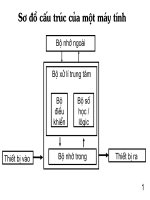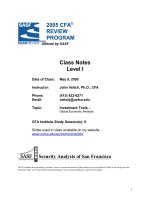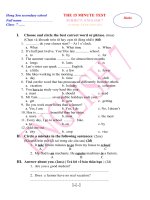CFA CFA level 3 CFA level 3 CFA level 3 CFA level 3 CFA level 3 CFA level 3 finquiz item set questions, study session 7, reading 15
Bạn đang xem bản rút gọn của tài liệu. Xem và tải ngay bản đầy đủ của tài liệu tại đây (27.1 KB, 4 trang )
Reading 15
Equity Market Valuation
FinQuiz.com
FinQuiz.com
CFA Level III Item-set - Question
Study Session 7
June 2018
Copyright © 2010-2018. FinQuiz.com. All rights reserved. Copying, reproduction or
redistribution of this material is strictly prohibited.
FinQuiz.com © 2018 - All rights reserved.
Reading 15
Equity Market Valuation
FinQuiz.com
FinQuiz Item-set ID: 11919
Questions 1(11920) through 6(11925) relate to Reading 15
Earl Webber Case Scenario
Earl Webber, CFA is an equity analyst serving Quantime Inc., a research firm. Webber is
currently studying several global equity markets would like to establish the valuation of U.S.,
Japanese, and German equity markets.
Webber has a particular interest in the Japanese equity markets and he finds these markets
particularly attractive for investment. He collects the following data for valuation purposes
(exhibit 1).
Exhibit 1
Japanese Market Index and Economic Data
Inflation adjusted growth in capital stock
Total factor productivity projected growth rate
Long-term labor projected growth rate
Output elasticity of capital stock
Current Japanese index level
Forecasted dividend growth into perpetuity
Forecasted 12-month dividend per share
2.5%
1.0%
0.0%
0.7
1,545
3.4%
¥115
Webber would also like to determine expected equity returns for Japanese corporate stocks. He is
aware that there are two approaches, bottom-up and top-down, which may typically be used to
estimate equity returns but is unsure of which approach is optimal. He contacts his long-time
friend and senior economist, Carl Knight. Knight offers two recommendations.
Recommendation 1: The tendency of the analyst, using the bottom-up approach for forecasting
purposes, to be influenced by overly-optimistic forecasts produced by
corporate managers may result in a greater preference for the top-down
forecasting approach which generates unbiased market forecasts.
Recommendation 2: In circumstances where forecasted changes in the Yen relative to foreign
exchange rates places certain local exporting corporations at an advantage,
a bottom-up or top-down approach may be utilized to estimate the
expected returns to be generated on investments in the affected
corporations’ stocks.
For his valuation of the U.S. corporate securities, Webber would like to use a model which:
accurately captures the riskiness of equity securities
fully accounts for the effect of inflation on security price returns
allows for changes in the input values over the evaluation horizon
FinQuiz.com © 2018 - All rights reserved.
Reading 15
Equity Market Valuation
FinQuiz.com
For his valuation of German equity markets, Webber’s colleague has suggested he should use the
Yardeni model to determine how German index stocks are valued relative to their current index
values. AA-rated corporate bonds currently yield 8.50% and the forecast for long-term earnings
growth is 13.45%. The German equity index’s current earnings yield stands at 4.00%. Webber
uses a 0.40 weighting factor for the analysis.
Webber’s colleague asks him how the inputs to the Yardeni model may affect fair value
estimates of the P/E ratio.
Jacques Rose is a junior research analyst serving Quantime Inc. Rose believes the Tobin’s q ratio
is particularly useful for valuing corporate securities and for equity market valuation. She would
like to determine how the conclusion for US equity market valuation would differ if she uses this
measure. Rose obtains data from the Federal Reserve database to arrive at an appropriate
conclusion (exhibit 2).
Exhibit 2
U.S. Market-Level Analysis using Federal Reserve Data
Market value or replacement cost of assets
Liabilities
Market value of equity outstanding
Long-term average for Tobin’s q and equity Q
Price-to-book ratio
$45,259
$30,234
$25,837
1.00
2.45
FinQuiz Question ID: 11920
1. The real-GDP growth using the Cobb-Douglas model is closest to:
A. 1.75%
B. 2.75%
C. 3.50%
FinQuiz Question ID: 11921
2. The required rate of return using the Gordon growth model is:
A. 9.2%
B. 10.8%
C. 11.1%
FinQuiz.com © 2018 - All rights reserved.
Reading 15
Equity Market Valuation
FinQuiz.com
FinQuiz Question ID: 11922
3. Which of the following recommendations, offered by Knight, accurately characterizes the
use of the bottom up and top-down approaches?
A. 1
B. 2
C. Both recommendations.
FinQuiz Question ID: 11923
4. Which of the following models will Webber most likely prefer for valuing U.S. corporate
securities given the specified model characteristics?
A. The Yardeni model.
B. The Fed model.
C. The P/10-year MA(E) model.
FinQuiz Question ID: 11924
5. Using the data on German index stocks, Webber will conclude that the stocks (using the
Yardeni model) are:
A. fairly valued
B. overvalued
C. undervalued
FinQuiz Question ID: 11925
6. Which of the conclusions will Rose least likely reach regarding the valuation of U.S. equity
markets (using the Tobin’s equity Q)?
A. U.S. equity markets are undervalued.
B. U.S. equity markets are overvalued.
C. The replacement costs of assets are understated.
FinQuiz.com © 2018 - All rights reserved.









